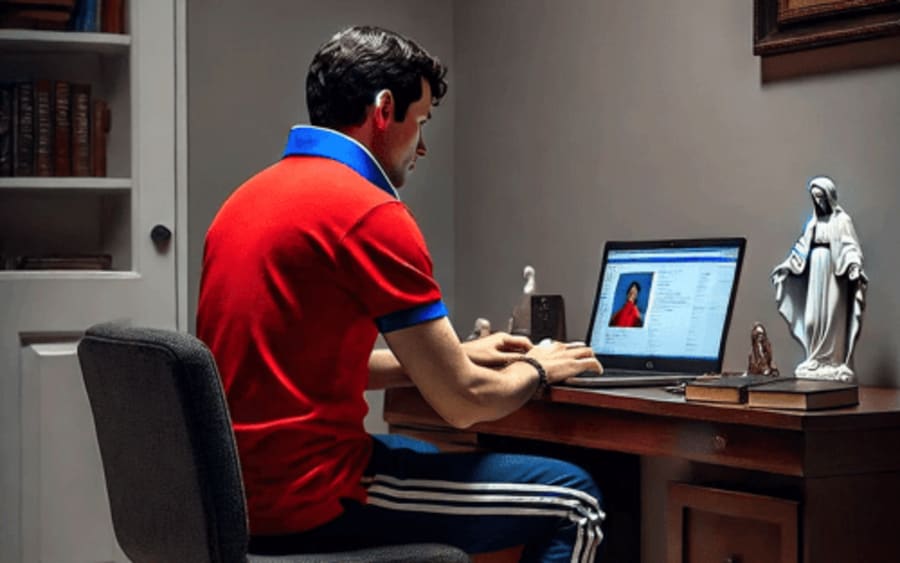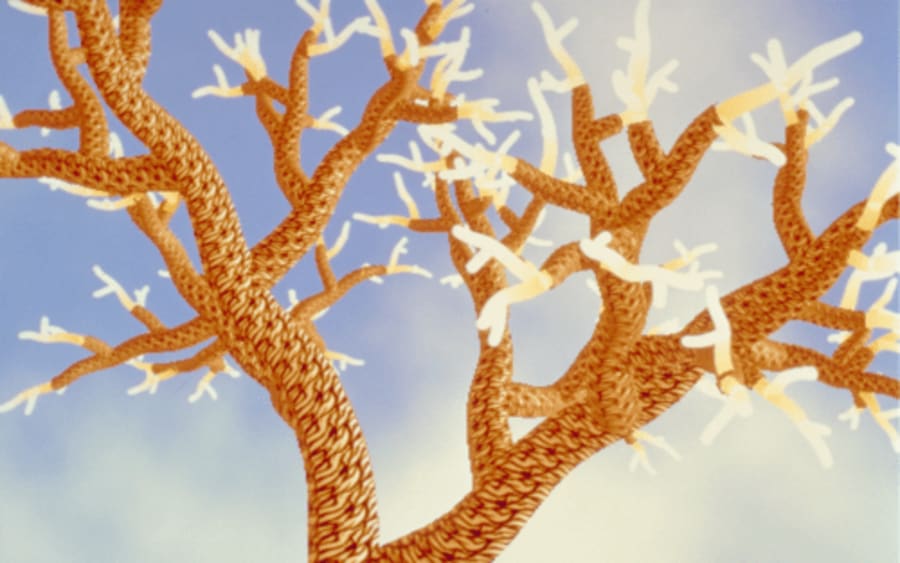‘The Internet was our ticket out of suburbia. We met in high school (yes, lol) in a small northern Italian town in the 1990s. We were the only two students interested in computers. At the time, they were still seen as equipment for insurance companies or the FBI – not as tools for artists. There were no art universities in the city back then, so we knew we had to leave as soon as possible.
‘Unlike most of our peers, we didn’t care much about TV because TV in Italy sucked. That’s probably why we were immediately fascinated by the Internet. It became our reality. After we left school, we moved to Berlin together. We owned nothing and produced no physical artworks: we were nocturnal, living in an empty attic with a mattress on the floor surrounded by computers. People thought we were crazy.
‘When the Internet was born in the mid-1990s, some artists began publishing their works online, using their websites as portfolios to show their paintings and sculptures. We thought that a new medium called for a new art. So, we started experimenting with an art form that could only exist online, that could only be created and seen there – an art that was “medium specific.” In other words, not “art on the Internet”, but “Internet art.”
‘One night in Ljubljana, we met Vuk Ćosić and found out we were not alone. There were at least, well, six other artists, scattered around the world, exploring similar paths! Ćosić even had a term to define the kind of things we were trying to do: Net Art. We had found our scene.
‘One of the first works we did was called Hybrids [1998]. It was an early experiment in which we remixed existing works of Net Art that we had copied. After downloading all the elements of a page, we would tinker with the source code, adding and removing pieces of code and checking the results in the browser, often relying on conflicting code and syntax errors. The ironic thing is that many of the original websites do not exist anymore, making our “pirated” versions the only existing ones.
‘At that time, we copied everything we liked, because we were not sure if we would find it again. Maybe it would disappear the next day. Maybe the whole Internet would disappear. We didn’t know how “permanent” this Internet thing was.
In 2000, we made a project called Life Sharing, commissioned by the Walker Art Center. For three years, we openly shared our home computer, making everything accessible through the Internet. All our artworks, as well as private material – including emails, texts, photos, and bank statements – were freely visible on our site. People could access and copy anything. It was very much inspired by the open-source-software movement, which was just starting. Social networks did not yet exist, and personal data was not yet a currency, so on Life Sharing you couldn’t buy or sell anything: no ads, no cookies, no data mining, just pure sharing.
‘We had very conflicting feelings about privacy. We were aware that the Internet could massively increase surveillance, and that every communication was archived somewhere – that it was becoming incredibly easy for companies and governments to profile users. That’s why the computer was filled with folders called Glasnost, Stasi, or Vopos. In this sense, Life Sharing probably anticipated the extent to which the Internet and social media have since become enmeshed in our self-image. With the passing of time, we became hyper-aware of ourselves, and the perhaps naive dream of complete accessibility slowly turned into a nightmare of self-design, to correct, adapt, and contradict that image. We unplugged it in 2003. Facebook launched the following year.
‘One of the turning points in our career was the invitation to show in the Slovenian pavilion at the Venice Biennale in 2001. We were only 24 and, up until that point, we had not done any exhibitions. It was also the first time that Net Art was being shown at the Venice Biennale, so the stakes were very high. We created a computer virus called Biennale.py and we released it on the night of the opening. It quickly spread around the world. In the pavilion, an installation featured two connected computers infecting and disinfecting each other in an endless cycle.
‘Once the virus was released, we immediately lost control. At 7pm, the pavilion opened its doors and all hell broke loose, journalists with recorders, televisions with cameras…We were expecting some interest, but we were completely overwhelmed by the media frenzy that followed. Biennale.py
was not only spreading as a piece of code, but – maybe even faster – it was spreading as a piece of news, the computer virus became a sort of meme. Not everyone hated it though, Harald Szeemann, the curator of the Biennale, called it that year’s most innovative project.
‘That work featured a lot of the elements we’d keep exploring in subsequent years, like Internet culture, circulation, virality, trolling, online-offline relations, etc. It was also a crash course in the artworld at large, outside of our Net Art niche, although we only really started working professionally as artists after we moved to New York in the mid-2000s.
‘We got into AI when it began to handle space and perspective. We started feeding it with photos of some of our previous works from the series “Personal Photographs” [2019–ongoing] – loops of cable tray hosting coils of brightly colored ethernet cable – and it generated lmost-realistic images of sculptures we might potentially have made. After generating the images, we built the actual sculptures, choosing materials, dimensions, and colors by interpreting the choices and mistakes of the AI. In other words, we generated a photographic version of “the work;” then, at a later stage, we worked backwards to create “the original.”
‘Generally, we’re late adopters. We tend to start using a technology only after we’ve seen how people are actually using it, which may be in a very different way from the intentions of its creator. For example, Emily’s Video [2012] is a piece of ours that compiles the reactions of various viewers while watching unknown – yet apparently horrible – footage. It was inspired by the so-called reaction videos that began to proliferate on YouTube in the mid-2000s. Who would have thought that, given the largest free video platform available to humanity, people would start filming themselves while watching others’ videos?
We just finished a new piece called J8~g#I|\;Net. Art{-^s1, which is a sculpture composed of two colored metal circuits connected by ethernet cables, constantly exchanging a single file. What they share is the email revealing the disputed origin of the term “net.art,” which was sent by the artist Alexei Shulgin to the mailing list Nettime on March 18, 1997. We’ve been meaning to make a piece about that email since we first heard the story some 27 years ago: finally, we’ve found the right solution. Talk about late adopters…
‘We live in a permanent state of disbelief, astonishment, and euphoria, induced by everything we see online. Every given minute, there’s a genius teenager in their bedroom producing the most amazing thing: an image, a joke, a video, a meme. Memes are the unconscious of the Internet, they make us think of new forms of fables, or myths, or folk art. We see them as an open window into the subconscious of humanity: observing how they are born and spread can reveal people’s innermost feelings, impulses, anxieties, fears, and desires.
‘As artists, we cannot compete with the Internet’s super-fast, ever-changing flow of images, ideas, and stimuli. There’s no point in trying to re-create that speed, that energy. What we can do is select one thing and isolate it from the rest to produce a moment of reflection on these processes – even if only for a minute.’
‘Poetics of Encryption’
Kunsthal Charlottenborg, Copenhagen
September 28, 2024 - January 12, 2025
Eva & Franco Mattes are represented by APALAZZO GALLERY.
Coline Milliard is Art Basel’s Executive Editor.
Caption for header image: Eva & Franco Mattes, Frankfurt, 2023. Photograph by Melania Dalle Grave for DSL Studio. Courtesy of APALAZZO GALLERY.
Published on September 20, 2024.


